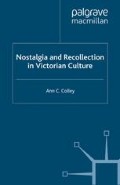Abstract
Whenever Robert Louis Stevenson wished to be released from the dualities inherent in the experience of the present, he often turned his attention to the absorbing spaces of his childhood and attempted to re-enter their flexible and synthetic landscape. Nostalgic for this prospect, he not only re-engaged the play, the vicarious violence, and the places of his early years but also began composing A Child’s Garden of Verses (1885).1 These poems offered him a sanctuary that was more durable and satisfying than that afforded by his nationalism, for they were his means of writing toward home and reclaiming, momentarily, what was no longer fully available to him. These verses helped him walk back into the spaces of his early years and recover what Carlyle termed the ‘elasticity’ of childhood.
Most of us, looking back on young years, may remember seasons of a light, aerial translucency and elasticity and perfect freedom; the body had not yet become the prison-house of the soul, but was its vehicle and implement, like a creature of thought, and altogether pliant to its bidding.
Thomas Carlyle, ‘Characteristics’ (1831)
Access this chapter
Tax calculation will be finalised at checkout
Purchases are for personal use only
Preview
Unable to display preview. Download preview PDF.
Notes
R. L. Stevenson, Virginibus Puerisque and Other Papers ( London: Chatto & Windus, 1905 ) p. 59.
B. Booth and E. Mehew, The Letters of Robert Louis Stevenson 1854–1894, VIII (New Haven: Yale University Press, 1994, 1995 ) p. 366.
R. L. Stevenson, Memories and Portraits ( New York: Charles Scribner’s Sons, 1897 ) p. 112.
R. L. Stevenson, Treasure Island (London: William Heinemann, 1924 ) pp. 139, 156.
R. L. Stevenson, Kidnapped ( New York: Bantam Books, 1982 ) p. 172.
R. L. Stevenson, The Amateur Emigrant, introd. J. Raban (London: The Hogarth Press, 1984) p. 15. As I explained in Chapter 3, when Stevenson traveled to America in August, 1879, he sailed on the Devonia a ship carrying emigrants from Scotland, Ireland, England, Scandinavia, Germany, and Russia who ‘had been unable to prevail against circumstances’ at home.
In The Master of Ballantrae the Master returns to his estate twice after being thought dead; the third time, however, he does not survive. In New York the Master arranged with his Indian servant, Secundra, to bury him alive and then when all is well to bring him out of his grave, but the plan does not work. With the assistance of Secundrâ s frantic attempts to resuscitate his body, the master revives but only briefly. The narrator describes the episode: Of the flight of time, I have no idea; it may have been three hours, and it may have been five, that the Indian laboured to reanimate his master’s body. One thing only I know, that it was still night, and the moon was not yet set, although it had sunk low, and now barred the plateau with long shadows, when Secundra uttered a small cry of satisfaction; and, leaning swiftly forth, I thought I could myself perceive a change upon the icy countenance of the unburied. The next moment I beheld his eyelids flutter; the next they rose entirely, and the week-old corpse looked me for a moment in the face. See R. L. Stevenson, The Master of Ballantrae and Weir of Hermiston introd. M. R. Ridley (London: Dent: Everyman’s Library, 1976) p. 187.
One of these fantasies occurred when Stevenson gleefully represented himself as a ‘murderer’ and impersonated ‘William Figg’ (one of the ironic personae Stevenson used in his correspondence with friends) who in ‘earlier and more thoughtless years’ had ‘been unjustly condemned for forgery, arson, stilicide, public buttery, and rape followed by murder in the person of twelve infant and flaxen-headed children of different sexes’. See D. Ferguson and M. Waingrow, eds, Stevenson’s Letters to Charles Baxter ( New Haven: Yale University Press, 1956 ) p. 113.
J. H. Buckley, William Ernest Henley: A Study in the ‘Counter-Decadence’ of the Nineties (Princeton: Princeton University Press, 1945) p. 7.
R. L. Stevenson, Dr Jekyll and Mr Hyde ( Toronto: Bantam Books, 1981 ) p. 97.
Copyright information
© 1998 Ann C. Colley
About this chapter
Cite this chapter
Colley, A.C. (1998). The Landscape of A Child’s Garden of Verses. In: Nostalgia and Recollection in Victorian Culture. Palgrave Macmillan, London. https://doi.org/10.1057/9780230373112_6
Download citation
DOI: https://doi.org/10.1057/9780230373112_6
Publisher Name: Palgrave Macmillan, London
Print ISBN: 978-1-349-40620-3
Online ISBN: 978-0-230-37311-2
eBook Packages: Palgrave Literature & Performing Arts CollectionLiterature, Cultural and Media Studies (R0)

